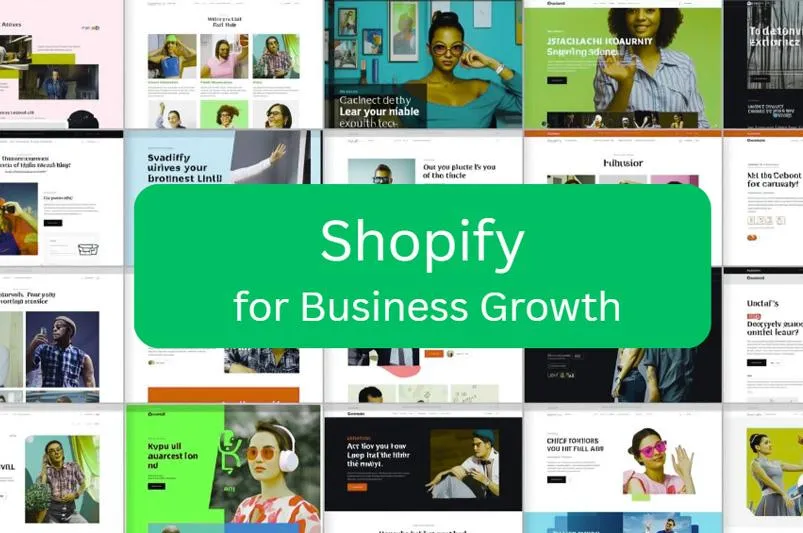
Shopify for Business Growth: A Practical Guide to Features, Plans, and 2025 Updates
Running an online business today means making smart decisions about your tools. One of the biggest questions entrepreneurs ask is: Which e-commerce platform will help me grow without creating unnecessary headaches?
Shopify consistently rises to the top because it combines ease of use with the scalability needed to support serious growth. From solo entrepreneurs to household-name brands, it’s a platform that has earned trust across the board.
In this guide, we’ll walk through Shopify’s features, pricing structure, and the most important updates for 2025. I’ll also highlight what these changes mean for small business owners who want to scale profitably without getting lost in complexity.
Why Shopify Matters in 2025
Shopify isn’t just another storefront builder. It powers over 4.8 million active online stores worldwide, holding nearly 30% of the U.S. e-commerce software market. That reach and adoption tell us two things:
It works at every level. Whether you’re just starting out or processing thousands of orders a day, Shopify’s framework adapts to your needs.
It’s battle-tested. From Tesla to Pepsi to small family shops, Shopify is proven to handle both ends of the spectrum.
For entrepreneurs, this is crucial. It means you’re not gambling on a tool that might fizzle out in a year—you’re investing in a platform with staying power.
Core Features That Drive Growth
1. Website Design Without the Tech Headaches
Shopify’s 250+ professional themes let you create a modern, mobile-friendly store without hiring a developer. In 2025, Shopify Magic, their AI-powered design assistant, takes this a step further by building a full storefront based on just a short description of your business.
Example: An artisan jewelry maker launched a fully branded online shop in just a weekend using Shopify Magic. What once required weeks of setup now takes hours.
2. Seamless Payments and Checkout
Shopify Payments integrates directly, supporting multiple global gateways.
Shop Pay allows customers to check out with one tap—boosting conversion rates.
Automatic tax calculations and built-in shipping integrations reduce manual errors and save hours.
3. Scalable Back-End Management
Shopify centralizes order management, inventory tracking, and customer communication. As your business grows, you won’t need to juggle multiple systems—Shopify’s ecosystem keeps everything in one place.
4. Marketing and Sales Tools
Built-in SEO features
Email marketing integrations
Social media sales channels (Facebook, Instagram, TikTok, etc.)
Discount codes and abandoned cart recovery
These tools give small businesses the same reach and sophistication as big players, without expensive third-party software.

Shopify Pricing in 2025: Which Plan Fits?
Choosing the right plan is often the trickiest part. Here’s the breakdown simplified:
Starter – $5/month
Great for testing an idea or selling via social media. Limited scalability.Basic – $39/month
Best for early-stage businesses that want a branded store, basic reports, and app integrations.Grow – $105/month (formerly Shopify plan)
Designed for scaling: advanced reporting, more staff accounts, lower transaction fees.Advanced – $399/month
For established businesses needing custom reporting, more automation, and global expansion tools.Shopify Plus – $2,300+/month
Built for enterprise-level businesses with high volume, complex operations, and dedicated support.
👉 Pro Tip: Don’t overspend early. Most small businesses thrive on the Basic or Grow plan until revenue justifies a bigger leap.
What’s New in 2025: Shopify Editions
This year, Shopify introduced over 300 updates, with AI and checkout optimization taking center stage. Here are the highlights worth noting:
AI-Driven Store Creation – Shopify Magic now builds entire product pages, collections, and even branded imagery in minutes.
Checkout Speed & Reliability – Faster load times reduce cart abandonment, giving businesses a measurable boost in conversions.
B2B Tools – Expanded features for wholesale, corporate accounts, and custom pricing models.
Performance Enhancements – Improved site speed across all themes, critical for SEO and user experience.
These aren’t just “nice-to-have” updates—they directly impact revenue by making it easier for businesses to get online, convert shoppers, and operate efficiently.
Case Study: Scaling Smarter with Shopify
A boutique coffee roaster moved from a DIY website to Shopify Basic. Within six months, they:
Increased online sales by 40% thanks to abandoned cart recovery and Shop Pay.
Cut fulfillment errors by half using integrated shipping and tax tools.
Expanded into wholesale using Shopify’s B2B features.
This shows how even small upgrades in systems can create significant growth without burning out the owner or team.
Should You Choose Shopify?
Here’s the bottom line:
If you’re just starting, Shopify lowers the barrier to entry with intuitive design and affordable plans.
If you’re ready to scale, it provides the tools, integrations, and reliability you need.
If you’re enterprise-level, Shopify Plus delivers full customization and global reach.
The flexibility makes Shopify not just a tool for today, but a partner you can grow with for years.
Conclusion
In e-commerce, the right platform can make or break your ability to grow profitably. Shopify remains a leader because it combines simplicity for beginners with powerful tools for scaling businesses. With AI innovations, streamlined checkout, and scalable pricing tiers, it’s well-positioned to support entrepreneurs at every stage.
If you’re considering launching or upgrading your online store, Shopify deserves to be at the top of your list.
Want to explore whether Shopify is the right fit for your business?
Contact David Rivero for a personalized growth strategy session.
Not sure which Shopify plan fits your business best?
We’ve created a quick-reference Shopify Plan Comparison Cheat Sheet that breaks down each 2025 plan side by side. It also includes tips on when to upgrade and a bonus checklist of must-have apps for new stores.
